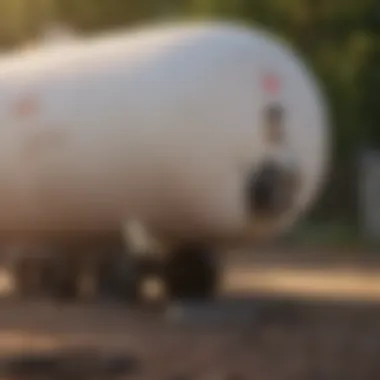Guide to Acquiring a Propane Tank: Tips and Insights


Intro
Propane is a versatile fuel used for heating, cooking, and even powering vehicles. Knowing how to acquire a propane tank is essential for residential and commercial needs. This guide will cover the methods of obtaining a propane tank, safety considerations, refill options, and maintenance practices.
Understanding Propane Tanks
Before acquiring a propane tank, it’s important to understand the different types available. Residential users typically need smaller tanks, while larger, commercial operations may require bigger tanks.
Types of Propane Tanks
- Portable Tanks: These are typically 20 pounds for grills.
- Above-Ground Tanks: Commonly found in residential areas.
- Underground Tanks: Often used for larger properties or businesses.
Each type has a specific application, so knowing which one fits your needs is crucial.
Key Considerations
When selecting a propane tank, consider the following:
- Size: Evaluate how much propane you will use.
- Type: Choose between portable, above-ground, or underground based on your requirements.
- Local Regulations: Verify if there are any zoning laws that influence placement and installation.
Important Note: Always check local regulations regarding propane tank installations and safety standards.
Where to Get a Propane Tank
Acquiring a propane tank can happen through several avenues:
Retail Stores
Many large retail chains offer propane tanks for purchase. Stores like Home Depot or Lowe’s often have a selection.
Specialty Suppliers
Propane suppliers like Ferrellgas provide both sales and rentals. Often, these suppliers can offer delivery and maintenance services.
Online Platforms
With the rise of e-commerce, purchasing a propane tank online is also an option. Websites such as Amazon offer various models, but ensure to check shipping policies as tanks may have restrictions.
Safety Standards
Safety is a key consideration when dealing with propane tanks. It is critical to understand the standards set by the National Fire Protection Association and local fire codes. Proper installation and maintenance are necessary to prevent leaks and accidents.
Recommended Safety Practices
- Store tanks upright and in a cool, ventilated area.
- Regularly check for leaks with soapy water.
- Install a propane detector in your home or business.
Maintenance Tips
Maintaining your propane tank is necessary for safe operation. Regular inspections will enhance its lifespan and ensure efficiency.
Inspection and Care
- Inspect the tank for rust or damage and report any issues.
- Ensure the valves are functioning properly.
- Periodically check the gauge to monitor propane levels.
By understanding how to get and maintain a propane tank, you are better equipped to utilize this resource safely and effectively. This guide aims to arm readers with the knowledge they need to make informed choices while navigating the various options available.
Understanding Propane Tanks


Understanding propane tanks is crucial for effectively planning their use in both residential and commercial settings. Knowledge about propane tanks aids in selecting the appropriate type and size for individual needs. A well-informed approach ensures safety and optimal usage, avoiding common mistakes that can lead to inefficiencies or hazards. Furthermore, understanding the regulations and standards governing propane usage contributes to responsible ownership and compliance with local laws.
What is a Propane Tank?
A propane tank is a specialized container designed to store propane gas, which is commonly used for heating, cooking, and various outdoor applications. These tanks come in different sizes and forms, depending on their intended use. The primary purpose of a propane tank is to ensure that propane remains in a gaseous state under pressure, making it readily available for use when needed. Propane gas is favored for its efficiency and portability, and understanding the characteristics of these tanks helps to maximize these benefits.
Types of Propane Tanks Available
- Portable Tanks
Portable tanks are compact and lightweight, making them an ideal choice for people who require mobility or seasonal use. Their key characteristic is their ability to be moved easily from one location to another. This feature makes them popular among outdoor enthusiasts, barbecue lovers, and camping enthusiasts.Unique to portable tanks is their varied capacity, which can cater to many needs. They typically hold between 5 to 20 pounds of propane. However, their smaller size may mean that users need to refill them more frequently compared to larger tanks. - Above Ground Tanks
Above ground tanks offer a larger storage capacity, making them suitable for residential heating or commercial needs. They can hold various volumes, often from 120 gallons to 1,000 gallons or more. The primary advantage of above ground tanks is ease of access for maintenance and refilling, which simplifies the management of fuel supply.A unique feature of these tanks is their visible installation. This allows for regular inspections and ensures that any issues can be detected quickly. On the downside, they take up more space and can be subject to environmental impacts such as rust, which may require regular maintenance. - Underground Tanks
Underground tanks are buried below the surface, which has aesthetic benefits for residential areas, as they minimize visual clutter. These tanks usually hold a larger volume of propane, often exceeding 500 gallons, making them suitable for long-term usage. One key characteristic is their protection from weather and environmental damage.However, these tanks do have disadvantages. Installation can be more complex and expensive due to the need for excavation and proper site evaluation. Moreover, detecting leaks might be more difficult as they are not easily accessible. This makes it essential to follow strict maintenance schedules to ensure safety.
Determining Your Propane Needs
Identifying the correct propane setup is crucial for effective use of this energy source. Each application has specific requirements, which dictate the size and type of propane tank needed. This section breaks down the aspects of propane usage that are essential for any home or business relying on propane.
Assessing Usage Requirements
Understanding how propane fits into your lifestyle or business model is the first step in determining your needs. Different applications consume propane at different rates, which impacts both the size of the tank and the refilling frequency.
Culinary Applications
Culinary applications often involve using propane for cooking or food preparation. Many restaurants and food trucks opt for propane because it provides consistent heat for grilling, frying, or baking. The key characteristic of using propane in culinary settings is its efficiency. Propane burns hotter than electric, allowing for better searing and cooking.
One unique feature of propane-powered cooking is its portability. Equipment like portable grills can be readily available, making it an ideal choice for catered events or outdoor gatherings. However, there are disadvantages, such as the need for proper ventilation to avoid gas buildup.
Heating Systems
Heating systems powered by propane are popular in colder climates. Propane furnaces and heaters are key for creating a warm, hospitable environment. The most significant advantage of utilizing propane for heating is its effectiveness over electric alternatives. Propane can heat spaces quickly and sustain warmth efficiently.
These systems are often equipped with programmable thermostats, which enhance energy savings. But, installation may be more complex than electric systems, requiring professional help upfront.
Outdoor Grilling
For many, outdoor grilling is a staple of summer fun and social gatherings. Propane grills are favored for their ease of use and ability to heat up quickly. The main characteristic of a propane grill is its convenience. They ignite with a simple push of a button and allow for precise temperature control.
A standout benefit of propane grilling is the flavor it imparts to food, making it a top choice for grill enthusiasts. However, the need to replace or refill tanks can be a minor inconvenience. Proper tank management ensures that grilling remains uninterrupted.
Calculating the Right Size
Once you have assessed your propane requirements, the next step is to determine the appropriate tank size. Tank sizes vary, and selecting the right one depends on your specific usage. If you use propane for multiple applications, consider your combined consumption to choose a tank that supports your needs without constant refilling.
Remember: The goal is to select a tank that minimizes empty periods while accommodating your consumption habits effectively.
Keep in mind that selecting too small a tank leads to frequent refueling. On the other hand, a larger tank can mean higher upfront costs and space considerations. Explore local regulations and consult suppliers to ensure informed decision-making when choosing a size.
Where to Acquire a Propane Tank
Acquiring a propane tank is a crucial step for anyone looking to utilize propane for various applications, such as heating, cooking, or grilling. Understanding where to obtain a propane tank can significantly streamline the selection process and ensure that users choose a reliable source. In this section, we'll explore different avenues to acquire a propane tank, examining the benefits, considerations, and specific elements that different suppliers provide.
Retail Locations and Home Improvement Stores
Retail locations like Walmart and Home Depot are among the most convenient places to acquire propane tanks for residential usage. These stores often have a range of sizes available, from small portable tanks for outdoor grills to larger tanks for home heating.
One essential benefit of purchasing from these stores is the immediate availability. Customers can often take the tank home on the same day. Additionally, many of these retailers offer tank exchange programs. This allows users to trade an empty cylinder for a full one, simplifying the refilling process.
However, there are some considerations. Prices may vary between stores, so it is advisable to compare costs before making a purchase. Some stores may also have seasonal sales or promotions that can reduce the overall expense. Furthermore, it's important to check that the tanks meet the local safety regulations.
Specialty Gas Suppliers


Specialty gas suppliers, such as AmeriGas and Ferrellgas, focus specifically on propane and propane-related services. These suppliers typically offer a more extensive range of services compared to general retail stores, so they may be suitable for both residential and commercial users.
By choosing a specialty supplier, customers can benefit from expert advice regarding the size and type of propane tank that best suits their needs. These companies may also provide delivery services and maintenance options, ensuring ongoing support after the initial purchase.
Moreover, specialty suppliers often adhere strictly to safety regulations and can provide guidance on local regulations that need to be observed. This can reduce concerns related to compliance and increase peace of mind for users.
Online Options and Delivery Services
The rise of online shopping has also impacted how consumers can acquire propane tanks. Websites like PropaneTankStore.com and propane.com offer a range of purchasing options for various tank sizes and types. The convenience of shopping online allows users to compare prices and features without the pressure of a salesperson.
In many cases, online transactions come with delivery services. This means that customers can have their propane tanks delivered to their homes, saving time and effort. This is particularly important for those who may not have access to transportation or prefer not to handle heavy tanks.
When opting for online purchases, it is essential to ensure that the vendor is reputable. Checking customer reviews and ratings can provide insight into the quality of the service. Additionally, confirming that the tanks are certified and meet safety requirements can prevent potential issues.
"Choosing the right source for your propane tank is vital for safety and convenience."
In summary, there are several valuable options for acquiring a propane tank. Retail locations provide convenience and immediate availability, specialty suppliers offer expertise and comprehensive services, and online options allow for ease of shopping and delivery. Assessing your personal needs and doing a bit of research can greatly influence the best choice for securing a propane tank.
Safety Standards and Regulations
When discussing the acquisition and use of a propane tank, understanding safety standards and regulations is critical. These guidelines play an essential role in ensuring not only the functionality of the tank but also the safety of individuals and property. Compliance with established standards can prevent accidents, leaks, and other hazardous situations that may arise from improper handling or installation. Furthermore, knowledge of local regulations helps users avoid potential fines or legal issues while promoting a safer community.
Local Regulations to Consider
Local laws governing propane tank use vary significantly across regions. Before purchasing, it is crucial to investigate the specific regulations in your area. Factors to consider include:
- Tank Size Limits: Some jurisdictions may restrict the size of propane tanks allowed for residential or commercial use.
- Installation Codes: Regulations may dictate how and where a propane tank can be installed, especially regarding distance from structures or property boundaries.
- Permitting Requirements: In certain areas, a permit may be necessary for the installation or substantial modifications of a propane system.
In addition to municipal regulations, state laws may apply as well. Checking with local authorities or fire departments is advisable to ensure compliance. Not all locations have the same rules, so doing thorough research helps to avoid repercussions later.
Safety Certifications and Markings
Understanding safety certifications and markings on propane tanks is vital. These labels indicate compliance with safety and quality standards set by organizations such as the American National Standards Institute (ANSI) or the Underwriters Laboratories (UL). Common markings to look for include:
- DOT Approval: Indicates that the tank meets the standards set by the Department of Transportation for transportable propane containers.
- ASME Certification: Pertains to tanks intended for stationary use, ensuring they adhere to strict engineering standards.
- Inspection Date: Tanks should have a date indicating when they were last inspected; regular inspections help maintain safety and functionality.
Having this knowledge allows users to make informed choices and ensures confidence in the equipment's safety. As a propagator of good practices, understanding these certifications can lead to better decisions regarding equipment and its usage.
"Always prioritize safety by adhering to regulations and selecting properly certified equipment."
Being diligent regarding safety standards and local regulations serves not only as a preventative measure but is an essential aspect of responsible propane use.
Inspecting Your Propane Tank
Inspecting your propane tank is not just an occasional chore; it is a critical task that ensures safe and efficient operation. Regular inspections can help you identify potential problems before they escalate, helping to prevent accidents. Given the nature of propane, a flammable gas, safety must always be the priority. Neglecting proper inspection can lead to serious health risks, property damage, and environmental hazards.
Knowing what to look for during an inspection is essential. At a minimum, every inspection should include a check for leaks, corrosion, or any signs of wear. Understanding how to conduct these inspections can lead to better maintenance practices, which can ultimately prolong the life of your equipment.
Inspecting your propane tank regularly contributes to peace of mind. You can be confident that your propane storage meets safety standards and operates smoothly.
Visual Inspection Techniques
Conducting a visual inspection of your propane tank is the first step in ensuring its safe operation. Here are some techniques you can apply:
- Look for Rust or Corrosion: Examine both the exterior and the fittings for any signs of rust. Propane tanks that are older or have been exposed to the elements may develop surface corrosion that can compromise their integrity.
- Check for Dents or Unusual Shapes: A dented tank can indicate internal damage. Ensure the tank has a smooth and consistent shape; changes may signal underlying issues.
- Inspect Fittings and Valves: These parts are often the most susceptible to wear. Ensure that they are free of leaks and are functioning properly.
- Verify Pressure Gauge Accuracy: The pressure gauge should read accurately. An inaccurate gauge can lead to over- or under-filling, which can create dangerous situations.
It is advisable to perform these visual checks at least once a month, particularly in areas with harsh weather. Keeping detailed records of inspections may also provide valuable insight over time.


Identifying Leaks and Other Risks
The importance of leak detection in propane tank maintenance cannot be overstated. Identifying leaks early is critical for safety. Here are some methods for identifying leaks:
- Soapy Water Test: Mix a small amount of soap with water and apply it to the connections. If you see bubbles forming, that indicates a leak.
- Smell Test: Propane has a distinct odor, often described as similar to rotten eggs. Familiarizing yourself with this smell can help you detect gas leaks quickly.
- Listen for Hissing Noises: A hissing sound near gas fittings or valves can indicate a leak. If you hear this sound, look for the source immediately.
Once a leak is identified, immediate action is required:
- Evacuate the Area: Clear all people and pets away from the vicinity of the tank.
- Shut Off the Gas Supply: Turn the valve off, if accessible, to minimize the gas release.
- Contact a Professional: Do not attempt to fix the problem yourself. Call a licensed technician to handle the repairs safely.
Regular inspection practices for your propane tank represent an essential aspect of its maintenance. By diligently paying attention to visual cues and utilizing accurate detection methods, you can ensure the longevity and safety of your propane system.
Refilling and Maintaining Your Propane Tank
Managing your propane tank involves more than initial purchase. Refilling and maintaining it is crucial. Proper maintenance prolongs the life of the tank and ensures safety. A well-maintained tank functions more efficiently, reducing costs over time. Understanding how to refill the tank correctly also prevents potential hazards.
Finding Refilling Stations
To find refilling stations, there are several sources available. Many local gas stations and home improvement stores offer this service. Major chains like Home Depot or Lowe's often have refill options. Additionally, specialty gas suppliers can be a reliable source.
Online directories can simplify this search. Websites such as Yelp or even Google Maps allow you to see nearby refilling stations. You might also consider calling ahead. Some locations can reserve propane tanks for you. Ensuring you have the correct type and size is essential when refilling.
Maintenance Best Practices
Maintaining your propane tank is integral to ensure its safety and functionality. Some best practices to follow include:
- Regular Inspections: Check for rust, dents, or leaks regularly. Inspecting connection points and hoses can catch problems early.
- Keep It Clean: Dirt and debris can cause malfunctions. Clean the tank and its surroundings periodically.
- Proper Storage: Store the tank upright in a cool, dry place, away from direct sunlight.
- Follow Regulations: Adhere to local regulations about propane tank maintenance. Different areas may have unique rules.
Proper maintenance not only ensures safety but enhances the performance of your propane tank.
Alternatives to Traditional Propane Tanks
In today's world, various fuel sources are available for heating, cooking, and powering appliances. While propane tanks serve many residential and commercial needs, it is crucial to consider other options. Exploring alternatives can help consumers make informed choices based on efficiency, availability, and environmental impact.
Natural Gas Options
Natural gas is a popular alternative to propane. It is commonly supplied through pipelines, providing a convenient and often cost-effective energy source. A key benefit of natural gas is its continuous supply. Unlike propane, which must be stored in tanks, natural gas is delivered directly to homes and businesses.
Using natural gas can have economic advantages. The prices can be lower in many regions than propane, resulting in reduced energy costs over time. Additionally, natural gas burns cleaner, emitting fewer greenhouse gases, which may appeal to environmentally conscious consumers.
However, there are considerations to keep in mind. For those not connected to a natural gas line, conversion can be complex. Therefore, checking local infrastructure availability is critical. Furthermore, appliances designed for natural gas may not work correctly with propane without proper conversion.
Electric Grills and Appliances
Electric appliances, particularly grills, offer another alternative to propane. Their main advantage lies in convenience. Users need to plug them in to start cooking, eliminating the need for fuel storage. Products such as the Weber Q1400 Electric Grill provide versatility in cooking without traditional fuel concerns.
Electric grills and appliances are usually easier to maintain. There are no tanks to refill, and in many cases, they are simpler to clean. Moreover, many electric models are designed to be portable, catering to outdoor as well as indoor uses.
From an environmental perspective, electric devices can reduce reliance on fossil fuels, especially if powered by renewable energy sources. However, the effectiveness largely depends on electricity costs in your area. Electric devices may consume more energy, leading to higher utility bills, depending on usage and local energy prices.
Consider Each Alternative Carefully
Natural gas and electric options present alternatives that merit careful consideration based on your needs. Assess infrastructure availability, costs, efficiency, and environmental impact before committing to one solution.
Exploring these alternatives can empower consumers to make knowledgeable decisions that align with their specific circumstances and preferences.
End
Recap of Key Points
- Understanding Propane Tanks: Different types of tanks are available, making it important to choose one that meets specific needs.
- Determining Your Propane Needs: Always assess your usage requirements and calculate the appropriate size before making a purchase.
- Where to Acquire a Propane Tank: Options include local stores, specialty suppliers, and online delivery services.
- Safety Standards and Regulations: Pay attention to local regulations and ensure tanks meet safety certifications.
- Inspecting Your Propane Tank: Regular inspections help in identifying leaks and risks effectively.
- Refilling and Maintaining Your Propane Tank: Finding stations for refilling and adhering to maintenance practices are essential.
- Alternatives to Traditional Propane Tanks: Consider natural gas options and electric appliances as alternatives.
Encouragement to Research and Plan
It is inevitable that making an informed decision about getting a propane tank demands adequate research and careful planning. Each individual or business might have unique requirements that influence the choice of tank. Examine factors such as available space, frequency of use, and safety considerations when selecting a tank. Furthermore, understanding local regulations can prevent complications in the long run. Research does not end at the point of purchase; ongoing maintenance and safety checks should be routine. Today's resources, including websites and forums, offer vast information and community insights to help in this journey.
Knowledge is the key to making safe and effective choices regarding propane tanks.







